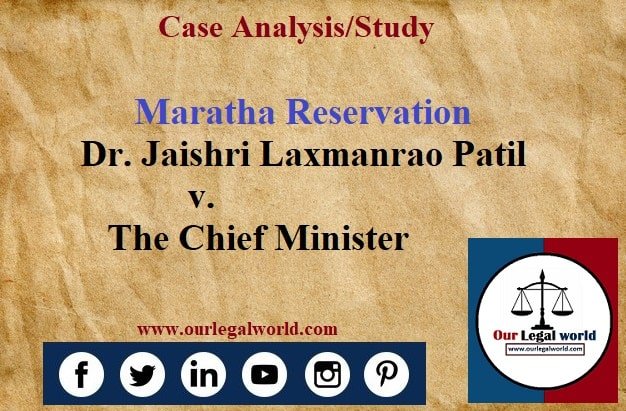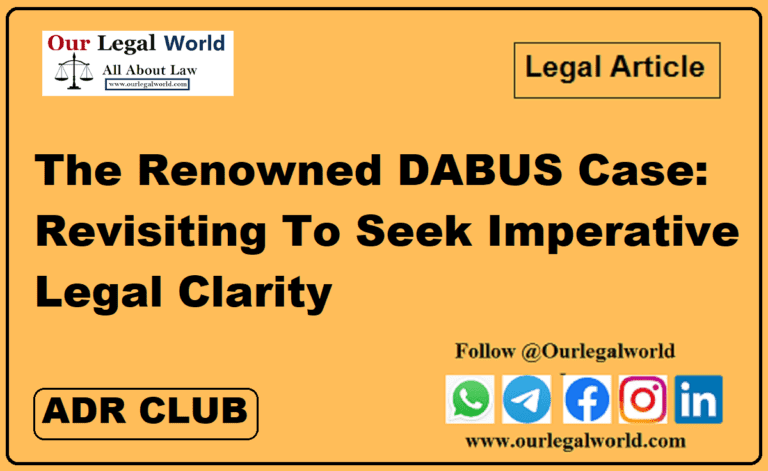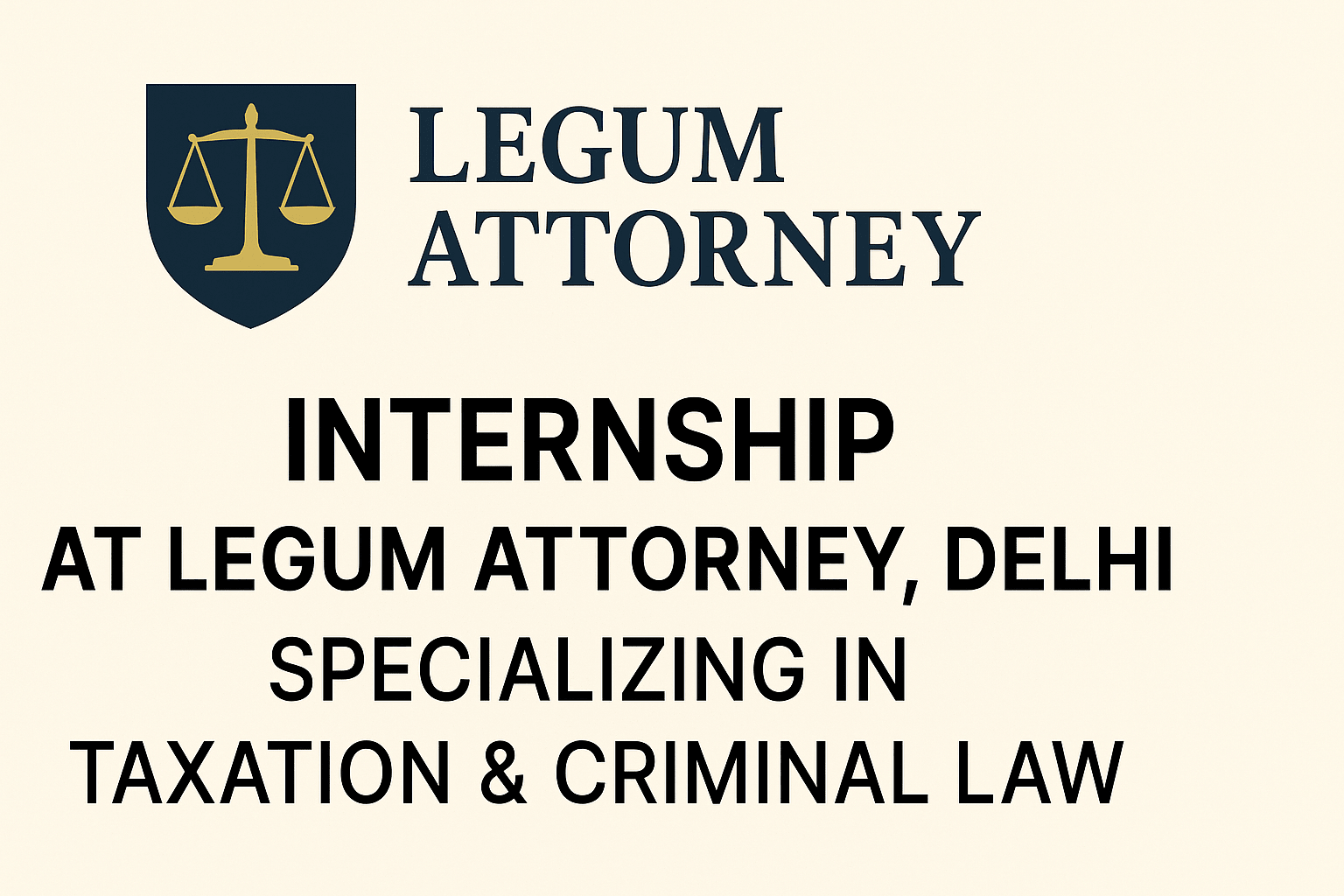Maratha Reservation Case Study – Dr. Jaishri Laxmanrao Patil v. The Chief Minister 2021
Introduction
The Supreme Court of India on 5th May 2021 set aside the Maratha quota reservation provided by the Maharashtra Government under Maharashtra State Socially and Economically Backward Class (SEBC) (Admission in Educational Institutions in the State and for posts for appointments in the State and for posts for appointments in public service and posts) Reservation Act, 2018[1]. A 5 judges constitution bench of Justice Ashok Bhushan, Justice S. Abdul Nazeer, Justice L. Nageswara Rao, Justice Hemant Gupta and Justice S. Ravindra Bhat dealt with total 6 issues wherein the bench was unanimous on 3 issues and fractured on the other 3 issues with a ratio of 3:2. One of the issues, amongst others, was whether the judgement of Indira Sawhney [2] must be revisited and the judges unanimously decided on this issue that the verdict was upright, has been followed by the court in several other cases and need not be re-examined.
The need to drive for equality amidst caste rule in India
Casteism in India is known to be more than 3000 years old. Casteism in simple terms means the division of the Hindus into different hierarchical groups based on an individual’s work and duty towards a particular custom or law. By now, it is obvious that religion, culture and traditions are the driving force behind this decade-old caste system. So how did this caste system come into force? It is said that the caste system was first justified in the Manusmriti which is regarded as the oldest and most important book on Hindu law. The caste system divides the Hindus into four main castes:
- Brahmins
- Kshatriyas
- Vaishyas
- Shudras
They were ranked in the same order with the Brahmins being the elite group and the Shudras, “the neglected and disadvantaged group”.
These four categories were further divided into various castes and sub-castes. The Brahmins were usually scholarly and highly educated people while the Kshatriyas were the warriors and rulers, the Vaishyas were generally the traders or merchants, and at the bottom of this structure were the Shudras who did the menial work and were regarded as untouchables. This caste system has always dominated the ruling of the society and all the major decisions taken in the society had the caste factor. All these four castes lived differently. They had separate houses, food and drinks were separated, the Brahmins did not go anywhere near the Shudras and inter-caste marriages were also prohibited. The upper castes were given everything as per their whims and fancies while the lower castes had to bear the brunt.
Amidst all this discrimination, the Constitution of India was drafted and Article 15 of the Constitution talked about a total ban on discrimination based on Caste. Further, to expand the equality provisions among the castes, the authorities introduced the quota system which meant reserving seats for the traditionally disadvantaged sections in government jobs and educational institutions. The traditionally disadvantaged included the scheduled castes and scheduled tribes, other backward classes, and the economically weaker sections of the society. These equality provisions given in the Constitution brought new hope that the country would be free from the shackles of the discrimination suffered in the past. The year 2021 marked India’s 72nd year of Independence and also 72 years of the Constitution’s reservation policy.
Maratha caste quota – an insight
The Supreme Court of India in 1992 came up with a landmark judgment in Indra Sawhney v. Union of India (1992) that changed the outlook of India’s reservation policy. This judgment upheld the Mandal Commission Report of 1991 and laid down two important provisions.
First, the criteria for giving reservation was social and educational backwardness. It stated that the total percentage of reservations in India is supposed to be 50% as mentioned in Article 16(4), beyond which no reservation would be given unless in exceptional circumstances.
Now, the Maratha community is a Shudra agrarian Community. The economic growth and development of the state of Maharashtra depend on them and other Shudra agrarian communities. The Marathas realized that they could not compete with the Dwijas and upper-caste non-Shudra communities in getting opportunities in educational institutes and other state services; because the Dwijas, like Brahmins, Kshatriyas, etc. had education rooted in them. Moreover, the Mandal Commission Report in 1991 which gave OBCs a separate quota, did not include the Maratha Shudra Agrarian community and many other Shudra communities. Further, the reservation limit was already 50% and the inclusion of the Marathas in the already existing other backward classes quota would have made the other beneficiaries of this group angry. Owing to all this, in 2018 the Maharashtra Government passed an Act called Socially and Educationally Backward Classes Act, 2018. This Act sought to give a 16% reservation to the Maratha Community in state services and higher education, separate from the already existing quotas.
The case of Dr. Jaishree Laxmanrao Patil v Chief Minister
The Maharashtra Socially and Educationally Backward Classes, Act 2018 was challenged in the Supreme Court citing that the 50% reservation rule in the 1992 Indra Sawhney landmark case, should be relied upon and the reservation should not be exceeded.
Facts of the case
On November 29th, 2018, the Maharashtra Socially and Educationally Backward Classes Act was passed upon the recommendation of the Maharashtra State Backward Classes Commission. The Gaikwad Committee recommended 12% and 13% reservation for Marathas in educational institutions and appointments in public services, respectively. As the Act exceeded the original quota limit, resultant to which, a bunch of petitions were filed before the Bombay High Court challenging the Maharashtra SEBC Act, 2018[3] on several grounds and one among them was that it breaks the glass ceiling of 50% quota which has already been settled by the Supreme Court. The Bombay High Court did not grant any interim stay on the act and eventually asked the government to reduce the quota of 16% to 12-13%, as was recommended by the Backward Class Commission.
Also Read: CYBER SEXUAL HARASSMENT LAWS IN INDIA
A number of appeals were filed before the Supreme Court of India against the verdict of the Bombay High Court. In September, 2020 the matter was referred to a larger bench of 5 judges with the moot question if the State Government has the power to declare socially and economically classes after the 102nd amendment of the Indian Constitution. Hearing in the matter was done for 10 days and the judgment in the matter was reserved on 26th March 2021. The order was pronounced on 5th May 2021 wherein the Maratha reservation was held to be unconstitutional.
The contention of parties
The primary arguments which were raised in front of the Bombay High Court were mainly that, the Act exceeded the 50% limit on the reservation which was brought in the case of Indra Sawhney v Union of India and that the Act was unconstitutional. Another contention was that the Gaikwad Commission Report was flawed and unscientific. Moreover, the Act violates Article 14, Article 16, and Article 19 of the Constitution of India as it gives a special reservation to the Marathas. And finally, the Act was passed without following the requirements given in the 102nd Amendment of the Constitution of India. On 27th July 2019, the Bombay High Court upheld the validity of the Act. On 12th July 2019, the Supreme Court admitted the Bombay High Court’s decision and chose to not stay the judgment. The Supreme Court further decided to refer the case to a larger bench.
Issues in the case:
There was total 6 issues in the case, which are enumerated as below:
- Whether judgment in case of Indra Sawhney needs to be referred to a larger bench or require a re-look by the larger bench in the light of subsequent constitutional amendments, judgments and changes social dynamics of the society?
- Whether the Maharashtra SEBC Act, 2018 granting reservation for Maratha Community in addition to 50% social reservation is covered by exceptional circumstances as contemplated by Constitution Bench in Indra Sawhney’s case?
- Whether the State Government on the strength of Maharashtra State Backward Commission Report has made out a case of existence of extraordinary situation and exceptional circumstances in the State to fall within the exception carved out in the judgment of Indra Sawhney?
- Whether the Constitution One Hundred-Second Amendment deprives the State Legislature of its powers to enact a legislation determining the socially and economically backward classes and conferring the benefits on the said community under its enabling power?
- Whether, State’s power to legislate in relation to “any backward class” under Article 15(4) and 16(4) is anyway abridged by Article 342(A) red with Articles 366(26c) of the Constitution of India?
- Whether Article 342A of the Constitution abrogates State’s power to legislate or classify in respect of “any backward class of citizen” and thereby affects the federal policy/ structure of the Constitution of India?
IMPORTANT PROVISIONS
The Constitution of India:
- Article 14: states the Equality of Law.
- Article 15: states the prohibition of discrimination on the grounds of religion, race, caste, gender, or the place of birth.
- Article 16: provides the equality of opportunities in the matter of public employment.
- Article 21: protects life and personal liberty
- Article 342: states Schedule Tribes
JUDGMENT:
1. A five-judge Constitutional seat, by a consistent view, additionally precluded that the need to rethink the 1992 nine-judge seat judgment in Indra Sawhney (Mandal Commission) case, which fixed 50% bar on the reservation.
2. The 569-page verdict may likely have far-reaching consequences on pending challenges to the validity of the Centre’s 10 percent Economic Weaker Section quota, and Tamil Nadu’s law for up to 69 percent reservation for the OBC. Against the backdrop of this verdict, the governments would need to prove exceptional circumstances to support their move.
3. The Supreme Court has said that the 2018 Maharashtra Act violates the principle of equality as embedded in Article 16 of the Indian Constitution. The exceeding of the reservation limit without there being any extra-ordinary circumstances violates the Article 14 and article 16 of the Indian Constitution which makes the enactment ultra vires, it added.
4. Several states had demanded review for the nine-judge bench decision insight of subsequent developments and alter in social dynamics. But the court stayed unmoved.
5. Justice Ashok Bhushan composing for the behalf of himself, and Justice S. Abdul Nazeer said: “There is often no fight that society changes, law changes, and individuals changes yet that doesn’t imply that something sweet and demonstrated to be useful in keeping up balance inside the general public ought to try and be changed in the name of the progress alone.
” 6. The Constitution seat directed by Justice Bhushan, saw that the pre-condition for penetrating a 50 percent limit on the quota under Article 16(4) like exceptional and extraordinary conditions wasn’t satisfied in giving 12% and 13% reservation to Marathas in jobs and education.
7. “The portrayal of Marathas publicly benefits in Grade A, B, C, and D includes 33.23%, 29.03%, 37.06%, and 36.53%, registered from out of the open classification filled posts, is a sufficient and acceptable portrayal of Maratha community,” it noted.
8. The other judges on the bench — Justices L. Nageswara Rao, Hemant Gupta, and S. Ravindra Bhat agreed that the Maratha quota was unconstitutional, and no review of a fifty percent cap is required.
9. The five-judge Constitution bench upheld the validity of the 102nd Amendment which granted constitutional status to the National Commission for Backward Classes.
10. However, Justices Bhushan and Nazeer’s point of view wasn’t agreed by the other three judges who held the state was empowered to spot the backward class for granting quota.
11. Justice Rao said there’s no obscurity in Article 342 A (1), instead it very clear that there should be one list of socially and educationally backward classes which can be issued by the President.
A good precedent
Hence, the Supreme Court struck down the Maharashtra Law giving reservations to the Maratha Community. The ruling is likely to impact other reservation laws under the category of exceptional circumstances as well on the reservations of economically weaker sections of the society that have access to the 50% limit. Before the Supreme Court, the Maharashtra Socially and Educationally Backward Classes Act, 2018 was turned down by various commissions and the demand for the reservation of the Maratha Community has been rejected before. It has been a political issue that has been brought up time and again in recent years. The quota issue continues to dominate in state politics with the parties promising quotas to the group. Going forward, the Maharashtra Government has some serious thinking to do regarding this judgment and the way ahead.
CONCLUSION
The Supreme Court struck down the arrangements of a Maharashtra law giving reservation to the Maratha community, which took the whole portion inside the state over the 50% bar set by the court in the 1992 Indra Sawhney judgment. “The half standard… is to fulfill the objective of correspondence as engrafted in Article 14 of which Articles 15 and 16 are facets… to vary the 50% is to have a general public which isn’t established on equity however upheld rank principle,” a five-judge Constitution Bench headed by Justice Ashok Bhushan administered in four separate choices. “The popular government is a significant element of our Constitution and a piece of our fundamental design. If the reservation goes above 50% limit… it will be a slippery slant, the political pressing factor, makes it difficult to scale back an equivalent,” it said.
Maratha Reservation – Dr. Jaishri Laxmanrao Patil v. The Chief Minister Written by Ankita Roy
BIBLIOGRAPHY
- https://blog.ipleaders.in/establishing-equality-place-caste-rule-scs-observations-case-dr-jaishree-laxmanrao-patil-v-chief-minister/
- https://www.linkedin.com/pulse/dr-jaishri-laxmanrao-patil-vs-chief-minister-others-civil-ojha
- https://www.lawyersclubindia.com/judiciary/dr-jaishri-laxmanrao-patil-vs-the-chief-minister-ors-maratha-reservation-law-was-struck-down-by-the-supreme-court-for-exceeding-a-50-cap-5201.asp
- https://indiankanoon.org/doc/178905262/








